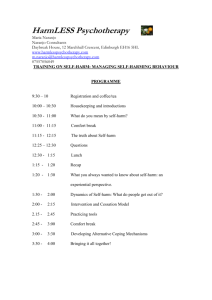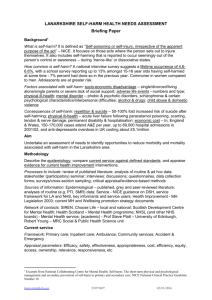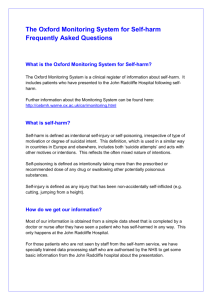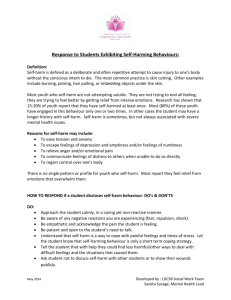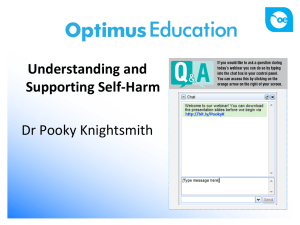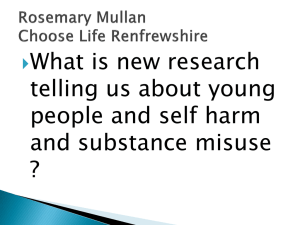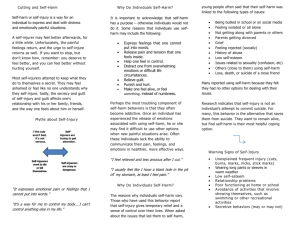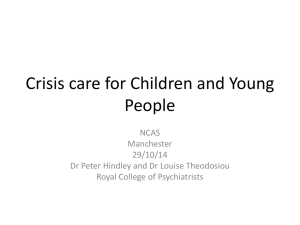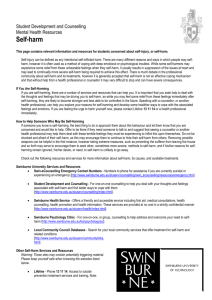Tuesday 13 March 2007 - APS Member Groups
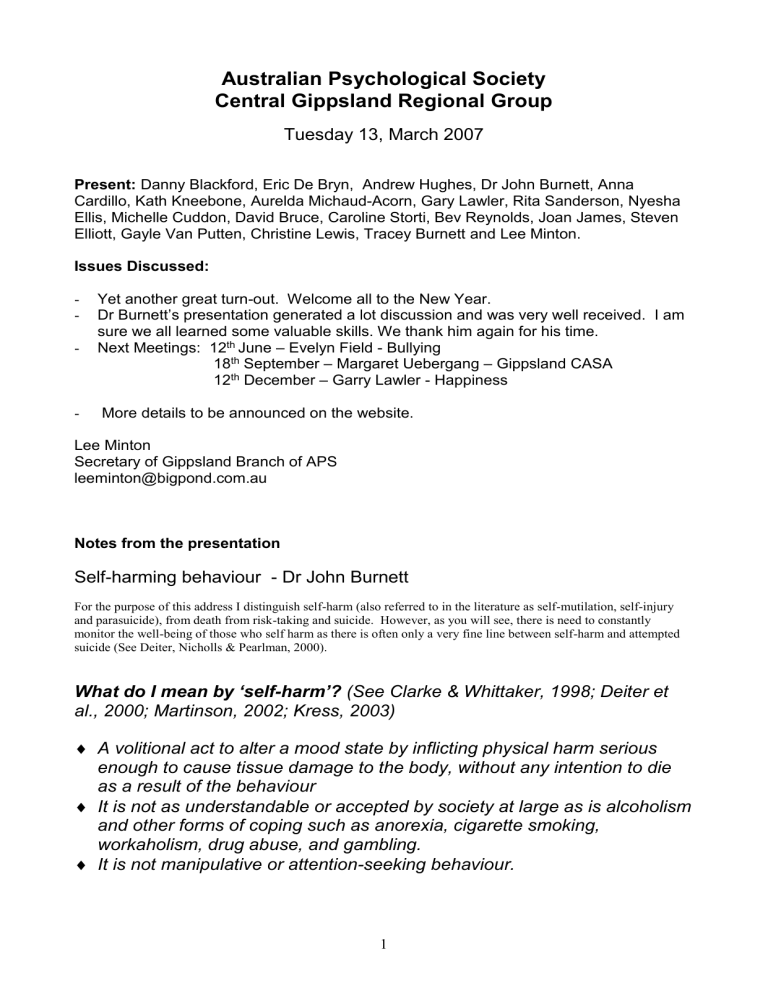
Australian Psychological Society
Central Gippsland Regional Group
Tuesday 13, March 2007
Present: Danny Blackford, Eric De Bryn, Andrew Hughes, Dr John Burnett, Anna
Cardillo, Kath Kneebone, Aurelda Michaud-Acorn, Gary Lawler, Rita Sanderson, Nyesha
Ellis, Michelle Cuddon, David Bruce, Caroline Storti, Bev Reynolds, Joan James, Steven
Elliott, Gayle Van Putten, Christine Lewis, Tracey Burnett and Lee Minton.
Issues Discussed:
Yet another great turn-out. Welcome all to the New Year.
-
Dr Burnett’s presentation generated a lot discussion and was very well received. I am sure we all learned some valuable skills. We thank him again for his time.
Next Meetings: 12
18
12 th June – Evelyn Field - Bullying th September
– Margaret Uebergang – Gippsland CASA th December – Garry Lawler - Happiness
More details to be announced on the website.
Lee Minton
Secretary of Gippsland Branch of APS leeminton@bigpond.com.au
Notes from the presentation
Self-harming behaviour - Dr John Burnett
For the purpose of this address I distinguish self-harm (also referred to in the literature as self-mutilation, self-injury and parasuicide), from death from risk-taking and suicide. However, as you will see, there is need to constantly monitor the well-being of those who self harm as there is often only a very fine line between self-harm and attempted suicide (See Deiter, Nicholls & Pearlman, 2000).
What do I mean by ‘self-harm’? (See Clarke & Whittaker, 1998; Deiter et al., 2000; Martinson, 2002; Kress, 2003)
A volitional act to alter a mood state by inflicting physical harm serious enough to cause tissue damage to the body, without any intention to die as a result of the behaviour
It is not as understandable or accepted by society at large as is alcoholism and other forms of coping such as anorexia, cigarette smoking, workaholism, drug abuse, and gambling.
It is not manipulative or attention-seeking behaviour.
1
It is not ‘self-harm’ if the primary purpose is:
Sexual pleasure
Body decoration
Spiritual enlightenment by ritual
‘Fitting in’ or ‘being cool’ - such as through substance abuse (alcohol and non-prescribed drugs) or drink driving
In contrast, what is meant by ‘suicide’?
Suicide is defined in the Concise Oxford Dictionary as ‘the intentional killing of oneself’.
It is a way out of a problem or a crisis that is invariably causing intense suffering (Kaplan,
Sadock & Grebb, 1994).
Those at high risk for suicide
•
Have a strong suicidal intent
•
Use methods with high lethality
•
Take precautions against being discovered
•
Tend to be suffering a psychiatric illness
•
Have made previous suicide attempt(s), particularly serious attempts
Suicide contrasted with self-harm (Kress, 2003)
•
The stimulus for suicide is unendurable psychological pain
•
The stimulus for self-harm intermittent psychological pain
•
The purpose of suicide is the seeking of a solution to an overbearing problem
•
The purpose of self-harm is the achieving of short-term alleviation
•
The goal of suicide is the cessation of consciousness
2
•
The goal of self-harm is the alteration of consciousness
•
The emotion associated with suicide is hopelessness / helplessness
•
The emotion associated with self-harm is alienation
•
The suicide internal attitude is that of ambivalence
•
The self-harm attitude is that of resignation
DSM-IV (Diagnostic criteria) – with reference to self-harm
Borderline personality disorder - self-mutilating behaviour
Factitious disorder - intentional production of physical . . . signs or symptoms
Stereotypic movement disorder - repetitive, non-functional motor behaviour . .
. (that can) result in self-inflicted bodily injury
DSM-IV (Diagnostic criteria) – with known implications for self- harm
Major depressive disorder -
Recurrent suicidal ideation
Schizophrenia -
About 50% of all sufferers attempt suicide and 10 - 15% die by suicide
Four-category classification of self-harm (Kress, 2003)
•
Stereotypic self-harm (non-functional / organic intellectual disabilities)
•
Major self-harm (thought disordered / extremely intrusive / e.g. eye enucleation)
•
Compulsive self-harm (automatic / e.g. trichotillomania)
•
Impulsive self-harm
- episodic (limited number of times in life)
- repetitive (almost an addictive quality)
Reasons for self-harming behaviour (Ministerial Council for Suicide Prevention
/ Child and Youth Health / Martinson, 2002)
To ease tension and anxiety
To escape feelings of depression and emptiness
To escape feelings of numbness
To relieve anger and frustration
To relieve intense emotional pain
To re gain control over one’s body
To maintain a sense of security or feeling of uniqueness
As a continuation of previous abusive patterns
To obtain a feeling of euphoria
To cope with feelings of alienation
As a response to self-hatred or guilt
To prevent suicide
Methods of self-harm
•
Cutting – 59% (10% seen in hospital emergency wards)
•
Medication overdose – 30% (90% of whom are seen in hospital emergency wards)
3
•
Illicit drugs – 3%
•
Hanging – 2%
•
Inhaling / sniffing – 2%
•
Self-battery (commonly head banging) – 2%
Research findings – Internet discussion groups (Murray, Warm and Fox, 2005)
•
Potential exists for deception / exclusions due to educational levels and socio-economic circumstances
•
Aged under 19 years
•
Respondents from USA, UK, Australia, Canada, and several other countries
•
113 (female) / 14 (male) – Average age 16.7 years
•
Age at starting –
One at 5 years / one at 8 years
26% at 13 years
19% at 14 years
13% at 15 years
12 % at 16 years
•
Histories –
31% victims of physical abuse
30% victims of sexual abuse
Eating disorders – 30% anorexia / 26% bulimia
32% stealing
12% alcoholism
12% drug addiction
•
50% self-harmed at night / 27% on a daily basis
•
Before self-harming, 77% reported feeling anxious and 88% feeling depressed
•
After self-harming, 15% reported feeling anxious and 36% feeling depressed
Research findings – (Australian) – Years 10 & 11 of 14 Gold Coast high schools
(De Leo & Heller, 2004)
•
3757 respondents – 1800 (f) / 1957 (m)
•
Average age 15.4 years
•
11% of females / 1.7% of males (within last year)
•
Overall 6.2% in this study (Range in Australia, UK and USA is 5-9%)
•
Acted after first thinking of self-harming
36% within 1 hour
A further 13% within 24 hours
An additional 26% within one month
An accepted view of self-harm – a coping mechanism
When people who self-harm are emotionally over-whelmed, an act of selfharm brings their levels of psychological and physiological tension and arousal back to a bearable level almost immediately.
This is why it is addictive
– it works!
It is a valid psychological problem in itself.
Eventually the negative consequences add up, and people do seek help.
How to assist the adolescent who self-harms (Humphrey, 2003)
If someone has told you they self-harm it is because they trust you.
Acknowledge the pain and distress that leads to such extreme acts such as self-harm.
Show compassion and empathy for the injuries.
4
Allow the adolescent to talk about the issues of personal shame, disgust, frustration or vulnerability.
Realise the adolescent has made heroic efforts to survive even though this has involved self-harm as a coping device.
Say that there are other ways of expression of feelings and encourage the adolescent to engage with a professional.
Knowing when ready to stop (Martinson, 2002)
While it is not necessary that all of the following criteria are met before stopping self-harm, the more of these statements that are true for the adolescent before deciding to stop this behaviour, the better.
1.
The adolescent has a solid emotional support system of friends, family, and/or professionals to access.
2.
The adolescent has at least two people who can be called if wanting to self-harm.
3.
Feeling comfortable talking about self-harm with three different people.
4.
Having a list of at least ten things to be done instead of self-harming.
5.
Having a place to go if needing to leave home so as not to self-harm.
6.
Feeling confident to get rid of all the things that might likely be used to self-harm.
7.
Having told at least two other people of the intention to stop self-harm.
8.
Being willing to feel uncomfortable, scared, and frustrated.
9.
Feeling confident to endure thinking about self-harm without actually doing it.
10.
Wanting to stop self-harm.
Treatment (See Loughrey, Jackson, Molla & Wobbleton, 1997; Martinson, 2002)
Should not be based on the practitioner’s personal feelings about the practice of self-harm.
Attempts to reduce or control the amount of self-harm a person does should be based in the adolescent’s willingness to undertake the difficult work of controlling and / or stopping the self-harm.
A medication regime is advocated as an adjunct to other forms of therapy such as rational / emotive therapy and cognitive/behavioural therapy, the latter including problem-solving therapy.
Psychological interventions
“From a distance”
Offer a token to remind the adolescent of the support being offered, linking it to -
Guided imagery (e.g. a favourite place), or
A relaxation exercise
“Face to face”
Rational / emotive therapy (challenging unhelpful thinking / exploration of feelings)
Cognitive / behavioural therapy
Alternative behaviours to suggest to the adolescent - (Matching action to the feeling of the moment) (Martinson, 2002 / Child and Youth Health)
Angry, frustrated, restless
Try something physical and violent, something not directed at a living thing:
5
1. Slash an empty plastic soda bottle or a piece of heavy cardboard or an old shirt or sock.
2.
Make a soft cloth doll to represent the things you are angry at. Cut and tear it instead of yourself.
3.
Flatten aluminum cans for recycling, seeing how fast you can go.
4.
Hit a punching bag.
5.
Use a pillow to hit a wall, pillow-fight style.
6.
Rip up an old newspaper or phone book.
7.
On a sketch or photo of yourself, mark in red ink what you want to do. Cut and tear the picture.
8.
Make Play-Doh or other clay models and cut or smash them.
9.
Throw ice into the bathtub or against a brick wall hard enough to shatter it.
10.
Break sticks.
(These things work even better if you rant at the thing you are cutting / tearing / hitting. Start out slowly, explaining why you are hurt and angry, but sometimes end up swearing and crying and yelling. It helps a lot to vent like that).
11.
Crank up the music and dance.
12.
Clean your room (or your whole house).
13.
Go for a walk / jog / run.
14.
Stomp around in heavy shoes.
15.
Play handball or tennis.
Sad, soft, melancholy, depressed, unhappy
1. Do something slow and soothing, like taking a hot bath with bath oil or bubbles, curling up under a comforter with hot cocoa and a good book, babying yourself somehow. Do whatever makes you feel taken care of and comforted.
2. Light a candle of sweet-smelling incense.
3.
Listen to soothing music.
4.
Smooth nice body lotion into the parts or yourself you want to hurt.
5.
Call a friend and just talk about things that you like.
6.
Make a tray of special treats and tuck yourself into bed with it and watch TV or read.
7.
Visit a friend.
Craving sensation, feeling depersonalized, dissociating, feeling unreal
Do something that creates a sharp physical sensation:
1. Squeeze ice hard (this really hurts). (Note: Putting ice on a spot you want to burn gives you a strong painful sensation and leaves a red mark afterward, like burning would).
2. Put a finger into a frozen food (like ice cream) for a minute.
3. Bite into a hot pepper or chew a piece of ginger root.
4. Rub liniment under your nose.
5. Slap a tabletop hard.
6. Snap your wrist with a rubber band.
7. Take a cold bath.
8. Stomp your feet on the ground.
9. Focus on how it feels to breathe. Notice the way your chest and stomach move with each breath.
Wanting focus
1. Do a task (a computer game, writing a computer program, needlework, etc) that is exacting and requires focus and concentration.
6
2.
Eat a raisin mindfully. Pick it up, noticing how it feels in your hand. Look at it carefully; see the asymmetries and think about the changes the grape went through. Roll the raisin in your fingers and notice the texture; try to describe it. Bring the raisin up to your mouth, paying attention to how it feels to move your hand that way. Smell the raisin; what does it remind you of? How does a raisin smell?
Notice that you're beginning to salivate, and see how that feels. Open your mouth and put the raisin in, taking time to think about how the raisin feels to your tongue. Chew slowly, noticing how the texture and even the taste of the raisin change as you chew it. Are there little seeds or stems? How is the inside different from the outside? Finally, swallow.
3.
Choose an object in the room. Examine it carefully and then write as detailed a description of it as you can. Include everything: size, weight, texture, shape, color, possible uses, feel, etc.
4.
Choose a random object, like a paper clip, and try to list 30 different uses for it.
5.
Pick a subject and research it on the web.
Wanting to see blood
1. Draw on yourself with a red felt-tip pen.
2. Take a small bottle of liquid red food coloring and warm it slightly by dropping it into a cup of hot water for a few minutes. Uncap the bottle and press its tip against the place you want to cut. Draw the bottle in a cutting motion while squeezing it slightly to let the food color trickle out.
3. Draw on the areas you want to cut using ice that you've made by dropping six or seven drops of red food color into each of the ice-cube tray wells.
4. Paint yourself with red tempera paint.
Wanting to see scars or pick scabs
1. Get a henna tattoo kit. You put the henna on as a paste and leave it overnight. The next day you can pick it off as you would a scab and it leaves an orange-red mark behind.
2.
Another thing that helps sometimes is the fifteen-minute game. Tell yourself that if you still want to harm yourself in 15 minutes, you can. When the time is up, see if you can go another 15. It is possible to get through a whole night this way.
Three take-home messages
Listen, listen, listen – “hear the feelings and not just the words”
Support personnel must be alert to counter-transference (single therapy relationship – can be either negative feelings about the adolescent or disproportionately positive reactions to the adolescent) and vicarious traumatization (cumulative effects of dealing with several stressful situations) reactions (Dieter et al., 2000).
Support personnel should seek administrative support, education, and counselling to relieve guilt, personal and professional conflict, and stress (Loughrey et al., 1997).
References
American Psychiatric Association (1994). Diagnostic and statistical manual of mental disorders: DSM IV
(4th ed.). Washington, DC: Author.
Barton, G., Rey, J. M., Simpson, P. & Denshire, E. (2000), Patterns and effects of critical incidents and their effect on outcome in an adolescent inpatient service. Australian and New Zealand Journal of
Psychiatry , 35 (2), 155-159.
7
Clarke, L. & Whittaker, M. (1998). Self-mutilation: culture, contexts and nursing . Journal of Clinical
Nursing , 7 , 129-137.
Deiter, P. J., Nicholls, S. S. & Pearlman, L. A. (2000). Self-injury and self capacities: Assisting an individual in crisis. Journal of Clinical Psychology , 56 (9), 1173-1191.
De Leo, D. & Heller, T. S. (2004). Who are the kids that self-harm? An Australian self-report school survey. MJA, 181(3) , 140-144.
Haines, J. & Williams, C. L. (1997). Coping and problem solving of self-mutilators. Journal of Clinical
Psychology , 53 (2), 177-186.
Haines, J., Williams, C. L., Brain, K. & Wilson, G. V. (1995). The psychophysiology of self-mutilation.
Journal of Abnormal Psychology , 104 (3), 471-489).
Hogg, C. & Burke, M. (1998). Many people think self-injury is just another form of attention-seeking.
Nursing Times , 94 (5), 53.
Hulse, G. K., Robertson, S. I. & Tait, R. J. (2001). Adolescent emergency department presentations with alcohol- or other drug-related problems in Perth, Western Australia. Addiction , 96 , 1059-1067.
Humphrey, T. (2003). Making connections . www.tased.edu.au/tasonline/mhcrc/self%20harm.html
Kaplan, H. I., Sadock, B. J. & Grebb, J. A. (1994). Synopsis of psychiatry: Behavioral sciences; clinical psychiatry (7 th ed.). Baltimore, MD: Williams & Wilkins.
Kress, V. E. W. (2003). Self-injurious behaviors: Assessment and diagnosis. Journal of Counseling &
Development, 81 , 490-496).
Loughrey, L., Jackson, J., Molla, P. & Wobbleton, J. (1997). Patient self-mutilation: When nursing becomes a nightmare. Journal of Psychosocial Nursing , 35 (4), 30-34.
Martinson, D. (2002). Self-injury: You are NOT the only one. http://www.palace.net/~llama/psycho/
Murray, C. D., Warm, A., & Fox, J. (2005). An internet survey of adolescent self-injurers. Australian e-
Journal for the Advancement of Mental Health (AeJAMH), 4(1) , ISSN: 1446-7984.
Selekman, M. D. (2006). Working with self-harming adolescents: A collaborative, strengths-based therapy approach. New York: W. W. Norton & Company.
Skegg, K. (2005). Self-harm. Lancet, 366(9495) , 1471-1483.
Thompson, D. (Ed.). (1995). The Concise Oxford Dictionary of Current English , (9 th ed.). Oxford:
Clarendon Press.
Some of many Internet Sites
www.cyh.com/cyh/yuothtopics (Child and Youth Health) www.goecities.com/Wellessley/1502/help.html www.mcsp.org.au (Ministerial Council for Suicide Prevention) www.selfinjury.org/docs/factsht.html www.tased.edu.au/tasonline/mhcrc/self%20harm.html www.text.kids.nsw.gov.au/publications/suiciderpt.html (NSW Commission for Children and Young
People) www.bnpca.org.au/publications/items/2004/06/00150-upload-00001.... www.mind.org.uk/Information/Booklets/Understanding+self-harm
8
